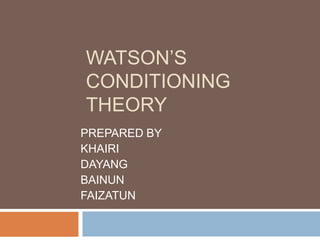Watson’s conditioning theory
•Télécharger en tant que PPTX, PDF•
5 j'aime•17,855 vues
Signaler
Partager
Signaler
Partager

Recommandé
Contenu connexe
Tendances
Tendances (20)
Similaire à Watson’s conditioning theory
Similaire à Watson’s conditioning theory (20)
Behaviorism explained with examples for B.Ed M.Ed & PhD

Behaviorism explained with examples for B.Ed M.Ed & PhD
Journal ofExperimental PsychologyVOL. I l l , No. i. F.docx

Journal ofExperimental PsychologyVOL. I l l , No. i. F.docx
Classical Conditioning according to Pavlov and J.b Waston 

Classical Conditioning according to Pavlov and J.b Waston
Plus de Khairunnisa' Mohammad
Plus de Khairunnisa' Mohammad (20)
Implementation of school based assessment(paling new)

Implementation of school based assessment(paling new)
Factors that motivate and demotivate young learners in

Factors that motivate and demotivate young learners in
Dernier
https://app.box.com/s/x7vf0j7xaxl2hlczxm3ny497y4yto33i80 ĐỀ THI THỬ TUYỂN SINH TIẾNG ANH VÀO 10 SỞ GD – ĐT THÀNH PHỐ HỒ CHÍ MINH NĂ...

80 ĐỀ THI THỬ TUYỂN SINH TIẾNG ANH VÀO 10 SỞ GD – ĐT THÀNH PHỐ HỒ CHÍ MINH NĂ...Nguyen Thanh Tu Collection
Dernier (20)
Python Notes for mca i year students osmania university.docx

Python Notes for mca i year students osmania university.docx
Food safety_Challenges food safety laboratories_.pdf

Food safety_Challenges food safety laboratories_.pdf
UGC NET Paper 1 Mathematical Reasoning & Aptitude.pdf

UGC NET Paper 1 Mathematical Reasoning & Aptitude.pdf
ICT Role in 21st Century Education & its Challenges.pptx

ICT Role in 21st Century Education & its Challenges.pptx
Micro-Scholarship, What it is, How can it help me.pdf

Micro-Scholarship, What it is, How can it help me.pdf
Sensory_Experience_and_Emotional_Resonance_in_Gabriel_Okaras_The_Piano_and_Th...

Sensory_Experience_and_Emotional_Resonance_in_Gabriel_Okaras_The_Piano_and_Th...
80 ĐỀ THI THỬ TUYỂN SINH TIẾNG ANH VÀO 10 SỞ GD – ĐT THÀNH PHỐ HỒ CHÍ MINH NĂ...

80 ĐỀ THI THỬ TUYỂN SINH TIẾNG ANH VÀO 10 SỞ GD – ĐT THÀNH PHỐ HỒ CHÍ MINH NĂ...
Beyond_Borders_Understanding_Anime_and_Manga_Fandom_A_Comprehensive_Audience_...

Beyond_Borders_Understanding_Anime_and_Manga_Fandom_A_Comprehensive_Audience_...
ICT role in 21st century education and it's challenges.

ICT role in 21st century education and it's challenges.
Kodo Millet PPT made by Ghanshyam bairwa college of Agriculture kumher bhara...

Kodo Millet PPT made by Ghanshyam bairwa college of Agriculture kumher bhara...
Fostering Friendships - Enhancing Social Bonds in the Classroom

Fostering Friendships - Enhancing Social Bonds in the Classroom
General Principles of Intellectual Property: Concepts of Intellectual Proper...

General Principles of Intellectual Property: Concepts of Intellectual Proper...
Plant propagation: Sexual and Asexual propapagation.pptx

Plant propagation: Sexual and Asexual propapagation.pptx
Watson’s conditioning theory
- 2. BACKGROUND This theory is proposed by J.B. Watson (1878-1958) He was an American psychologist and he was the first person to use the term behaviourism to study human behaviour. His research was greatly influenced by Pavlov’s Classical Conditioning Theory. Using Classical Conditioning Model, he made a research on children’s emotion.
- 3. EMOTION LEARNING BY STIMULUS GENERALIZATION According to Watson, human normally inherit three kinds of basic emotions : fear, anger and love. These emotions can be learned through the process of conditioning. This hypothesis is then followed by his experiment, assisted by Rayner (1920)
- 4. His subjects were a nine-month old baby, named Little Albert and a white, tame mouse. The purpose of this experiment was to prove that the feeling of fear towards the mouse can be learned through the process of conditioning. Initially, the baby liked to play with the white mouse. However, after given unconditioned stimulus, the baby was terrified at the sight of the mouse and everything resembling it.
- 5. 1. A white mouse was brought to Little Albert. Little Albert was interested in it and played with it. 2. The second time the mouse was shown to Little Albert, a loud, startling sound (unconditioned stimulus) was emitted all of the sudden from the back. 3. The reaction shown by the baby was fright and fear.
- 6. The mouse was a conditioned stimulus which Little Albert was familiar with. At first, he was not afraid of it. On the other hand, the loud, startling sound was an unconditioned stimulus which Little Albert was not familiar with. The sound came with the mouse all of the sudden and that has caused Little Albert’s fear. Each time the mouse was shown to Little Albert, it will be followed by the sound. In this way, a conditioned response (fear) was established.
- 7. The conclusion made was that, Little Albert had related the sound with the white mouse which he played with previously. Through this conditioning process (continuous exposure to the mouse and the sound), Albert has learned to respond with fear. Little Albert was also stimulated with other stimuli (white rabbit, fur coat, fury thing) and he responded the same way- fear. This is what Watson concluded as stimulus generalization – Little Albert has generalized that all fury and white things will make loud sounds, and thus he was afraid of them.
- 8. IMPLICATIONS OF WATSON’S THEORY IN TEACHING AND LEARNING 1. All types of behaviour can be learned through the conditioning process. Positive behaviour can be taught by using suitable stimulus. E.g : A teacher rewarding her student with candies (stimulus) each time he sweeps the floor. The student will adapt to this positive behaviour because of the stimulus.
- 9. 2. In order to master the skill of problem solving, pupils ought to relate the relationship between all responses systematically. 3. In order to consolidate what has been learned in the memory, more exercises should be carried out after learning (plays important in knowledge retention-long term memory) 4. During the teaching process, teacher should use suitable stimulus to motivate pupils in learning, (rewards) and at the same time, avoid using stimulus which will produce negative effect. (excessive punishments)
